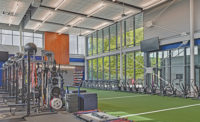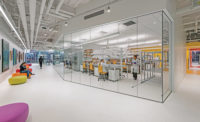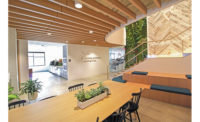Revenue declined for contractors in New York and New England, according to the 2020 Top Contractors rankings for each region, but executives say firms are ready to make up for lost time after temporary site shutdowns due to COVID-19.
On this year’s ENR New England Top Contractors ranking, the leading 35 firms (out of 37 on the list) reported $12.4 billion in 2019 revenue from work performed in Connecticut, Maine, Massachusetts, New Hampshire, Rhode Island and Vermont—about 0.16% less than reported by the 35 firms on last year’s list. The top five firms on this year’s list logged $5.2 billion in revenue, down nearly 14% from last year’s combined $6.02 billion recorded for the top five.
In New England, this year’s top five companies mirror last year’s, with Boston-based contractor Suffolk finishing first for the fourth time in five years. The firm’s $1.7 billion in revenue is up from last year’s $1.57 billion. Turner Construction Co. was No. 2 for the second straight year with $1.54 billion, up 11% from last year. Consigli Construction Co. ranked No. 3 for the third straight year with $1.12 billion in regional revenue, down 6.7%.
|
Related Links |
In New York and New Jersey, the top 50 companies (out of 53 on the list) reported about $27.1 billion in total revenue, down 1.2% compared with the total for the same number of firms last year.
The New York region’s top five firms reported $12.59 billion in revenue, more than half the total for all 53 firms on the list—up 0.8% from the $12.49 billion that the top five reported a year ago. The same company took third place this year and last: Structure Tone/Pavarini McGovern/STO Building Group, with $2.53 billion; the firm also landed at No. 10 on New England’s list.
The 2020 Contractor of the Year for the New York region, New Jersey-based Vericon Construction Co., reported 10% revenue growth to $143.77 million, attributed to longtime work in banking and increasing contracts in transportation (see p. NY/NE24).
Executives from Consigli, Suffolk, Structure Tone/Pavarini McGovern and Arc Building Partners, which was ranked No. 39 on the New York regional list with $87.43 million in revenue, shared regional market insights with ENR. Their responses have been edited for space and clarity.
What are major construction trends in the New England and New York regions?
Jeff Gouveia, President and General Manager, Suffolk Northeast: Industry as a whole has been primarily focused on safety. We implemented COVID-19 protocols established by each [New England] city and state around the more tactical standard safety guidelines including PPE, social distancing measures, hand washing stations, etc. We also were working on providing support and resources to address any anxieties and the emotions that came with dealing with a pandemic.
Frank Ciminelli, President & CEO, Arc Building Partners: As things get moving again [in New York, where all construction opened by early June], we’re also experiencing a shortage in capacity and potential limitations to productivity. We’re seeing major shifts in how the industry operates, with a greater focus on safety and well-being to accommodate the new state regulations and social distancing guidelines.
Michael Neary, President, Structure Tone: Some of our clients have chosen to delay restarting their projects so they can reevaluate the design in the wake of changing safety precautions and standards.
Michael Melanophy, Regional Vice President, Pavarini North: In Connecticut, we were able to continue working on many of our projects, so we … adjusted our health and safety practices and protocols by closely following guidance of the CDC, OSHA and state regulations. Some of our design partners are still reluctant to come to jobsites, and we’re all using technology in new ways to collaborate.
What sectors have offered your firm the greatest opportunity?
Anthony Consigli, CEO, Consigli: The pandemic has demonstrated an obvious need to continue investing in the life sciences industry as research is being conducted around the clock for vaccines. With the hub of life sciences in New England—especially in the Boston market—life sciences is an industry that is poised for additional growth. We are also seeing this as a growing need in New York City.
Gouveia: Since much of the workforce has shifted to remote work and working from home could be the new norm, it’s becoming increasingly important to have facilities that can house that data.
Ciminelli: Beginning pre-COVID, the sector [in the New York region] that has posed the greatest growth opportunity for us has been affordable housing. We’re seeing this trend continue in a consistent way as our communities recover from the impact of the pandemic.
Neary: In the New York region, the corporate office sector has always been our bread and butter. In the last few years, we’ve seen a lot of growth in the tech sector as major tech firms such as Google, Apple, Facebook, Spotify and others expand into new offices in New York City. Our health care division in New York, LF Driscoll Healthcare, has also gained a lot of steam … including working on emergency projects for hospital networks during the pandemic.
Michael Ryan, Senior Vice President, Structure Tone, Boston: Corporate workplaces have always been our strongest sector in Boston. Hospitality was a strong sector before the pandemic as well. Many of Boston’s major hotels have been in the midst of their upgrade cycle in the last two years.
Which sectors have cooled down?
Consigli: Higher education has … taken a significant hit, as there is a lot of uncertainty with incoming admissions and the residual impact on traditional revenue streams. Instead, we are likely to see smaller deferred maintenance and urgent repair projects, especially with empty campus buildings.
Gouveia: Aviation and hospitality are sectors that cooled down rapidly, considering the toll the coronavirus has taken on the airline and tourism industries in general.
Ciminelli: [In New York] hospitality has taken the biggest hit. As travel came to a nearly complete standstill, the level of investment also halted. Over recent years, we’ve also seen significant slowdowns in hospitals and higher education, especially in upstate New York.
Neary: We worry about the impact of COVID-19 on hospitality and retail. They went through some devastating financial impacts. The question now is, how do they come back and reinvent themselves?
What key innovations have helped your firm boost productivity or deal with the COVID-19 pandemic?
Charlie Avolio, General Manager of Suffolk New York: To enforce social distancing, Triax wearable monitors are placed on hard hats and sound audible alarms whenever workers are within 6 feet of each other. The device also allows us to collect passive worker interactions, which helps to facilitate contact tracing in case a worker tests positive for COVID-19.
Gouveia: Open Space is technology in which you mount a camera to the top of your hard hat to allow a [remote] team member to capture a 360-degree, real-time view of a project.
Consigli: Some important tools for us during this time have been aerial drone capture, services like Matterport that provide virtual tours and StructionSite, which is a collaboration platform for project teams, design partners and clients.
Ciminelli: Throughout 2019, we worked to integrate a management operating system, which allows us to incorporate a set of tools, meetings and behaviors used to manage our teams and processes. The system gave us a structure to organize all our initiatives … whether it is the refinement of a fully integrated ERP [enterprise resource planning], exploration of creative uses for virtual design and construction or implementation of lean construction principles.
Neary: A few years ago we refocused our safety program into Safety 360, our overriding safety culture that emphasizes a 360-degree, behavior-based view of safety.… We have seen a 25% reduction in our safety metrics.
Melanophy: For us, PlanGrid and Matterport have become our technologies of choice while members of the project team are working remotely. We’re using Matterport regularly to manage and chart progress, as well as PlanGrid extensively to move things along.
Where do you see the industry headed in the next year?
Consigli: There will absolutely be a need to adapt moving forward about consistent sanitation of tools and equipment, proper PPE and safety wear and overall a rethinking of what work has to be done on jobsites—who really needs to be based on site and who can work remotely.
Gouveia: We’re going to see a shift toward more prefabrication of project components in order to help adhere to social distancing requirements. A lot of what will change in the industry will also hinge on whether a vaccine is made available in the near future.
Avolio: New York City’s construction market as a whole can sometimes be the last place to fully embrace new changes, but COVID-19 has already spurred industry to begin adopting innovative new technology to supplement the safety guidelines outlined by public health officials.
Ciminelli: We expect to see a greater investment in innovation and planning that will make the industry more efficient. For instance, we are engaged as construction manager for a new $50-million affordable housing development in downtown Buffalo. To balance the budget versus the new state safety guidelines, which means a smaller crew on site, all materials are components of an offsite, prefabricated kit-of-parts. Similarly, we are engaged as construction manager at a new $45-million apartment and retail space for New Jersey City University in Jersey City, N.J. The wood framing is shop-built rather than built on site. This helped us be more efficient by mitigating the more expensive onsite labor.
Neary: Our clients are still determining how to return to their workplaces and projects, and they will dictate where the trends go.
Melanophy: Virtual collaboration became the new norm during the pandemic, so we expect to see more of that format in the future for meetings and presentations.
Ryan: In Boston, we expect COVID-19 to have lingering effects on how our clients approach their office projects. Some may entirely rethink their workplace, some may put plans to renovate or move on hold and others may make smaller adjustments. We may see impacts on hotel design as well.










